G.A.M.E.S. Campers Experience Bioengineering—and Have Fun
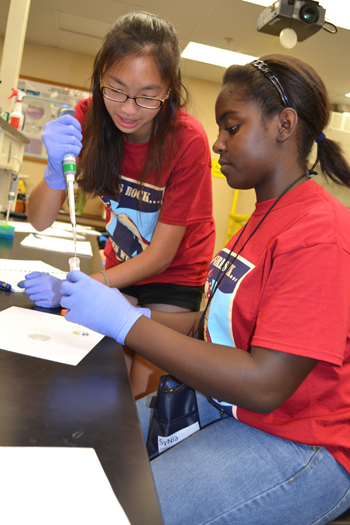
Bioengineering G.A.M.E.S. campers perform a task during the "Glowing Bacteria" session.
September 24, 2013
The 30 high school girls who attended the 2013 version of the Bioengineering G.A.M.E.S. camp this past summer (July 15–19) were exposed to some cutting-edge research, such as how bioengineering is addressing the delivery of drugs in cancer patients, or microfluidics—how fluids can be constrained to nano-scale devices to study them. However, the main intent of camp co-directors Jenny Amos and Olivia Cangellaris wasn't to recruit the girls into their field. They simply wanted to expose campers to some fun engineering.
"They don't know what engineers do on a regular basis," explains Bioengineering Senior Lecturer Jenny Amos, "or that engineers are women…that engineers can have fun...
"Or that engineers don't have to be professors," adds grad student Cangellaris. (Like-minded in their passion for G.A.M.E.S., the two tend to finish sentences for each other.)
She continues: "I think that's what's so great...students who wouldn't be exposed to this kind of discipline and don't know the different opportunities that are available and the training that you get as an engineer, they get to see that when they come to our camp—to any of the other camps."
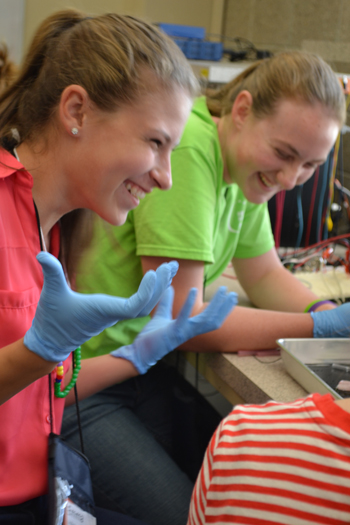
Girls enjoy a Bioengineering G.A.M.E.S. camp session.
While they say they weren't recruiting to their field, specifically, that didn't stop the two from showcasing exciting new bioengineering research via fun hands-on activities. Emphasizing a different theme each day, the camp exposed the girls to the broad spectrum that comprises bioengineering. Introducing the theme of the day each morning was biological anthropologist Kate Clancy, whose research— and blog—involve women's health.
For example, the session about drug delivery in cancer patients was part of Monday's emphasis on therapeutics. On Tuesday, cell and tissue day, the girls learned some basics of cell culture, then dissected a frog's leg muscle and explored how electrical stimulation affects muscles while learning about neuromuscular electrical stimulation. Wednesday's theme was imaging; with electrodes fastened to their arms and legs, the girls learned how motion capture works. During "Glowing Bacteria," one of Thursday's sessions about computational and synthetic biology, girls plated bacteria, then used a chemical to transfect it, which resulted in a green glow. Friday's theme was nano-biology. In addition to microfluidics—during the "All About Me" activity, girls received a booklet containing everything they'd learned about their own biology throughout the week, and were able to compare themselves to other girls in the camp.
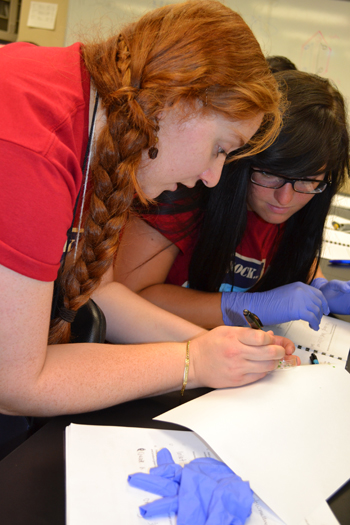
Olivia Cangellaris works with a camper during one of the sessions.
Although the camp began in 2007, the girls who attended back then probably wouldn't have recognized it. In fact, some campers from 2012 might not have recognized it either.
According to Amos, "The camp—it's different than it was last year, and I think it continues to evolve every year."
And now that the 2013 camp is over, Amos and Cangellaris, who have been collaborating for a couple of years now to co-lead the camp, are probably already brain storming to come up with some exciting new things for next year's camp.
Admits Amos, "I know, after camp last year, we had a camp debrief right afterwards, and Olivia and I were just so excited planning for this year. So I think right after this camp's over, we'll be so excited planning for next year. We tend to be the overachievers of the G.A.M.E.S. community. So we had the schedule pretty much set from January on."
Why do the two devote so much time and energy to planning and running a camp for high school girls? For Amos, it's a change of pace, and she hopes some of the girls will end up in STEM:
"I guess I do it because it's just so fun, and I get to work with a completely different population than I normally work with. And hopefully we inspire some girls, we change their minds, and get them into some form of science, even if it's not bioengineering. I would be happy if they went into any science."
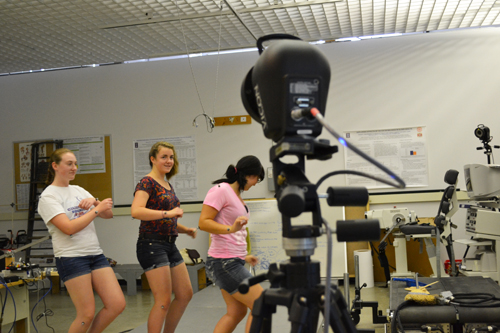
Equipped with special targets fastened to their arms and legs that infrared cameras around the room recognize, campers experience motion capture technology.
And Cangellaris? She appreciates the girls' enthusiasm: "It's really exciting to work with girls who are in high school. Some of them have never thought about what engineering is, and they come to camp, and they're so excited about it, and they're really engaged. And now that we're doing high school students, we have some campers that are actually entering their senior year, and they're always very inquisitive. They ask these very smart, astute questions."
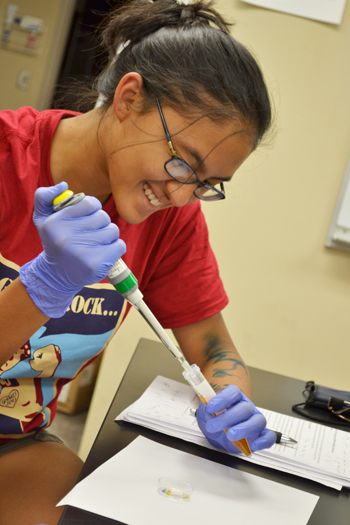 Camper performing a step in the Glowing Bacteria session.
Camper performing a step in the Glowing Bacteria session.She adds that their enthusiasm is contagious. "It's really great to interact with them because it kind of reminds you of how exciting engineering can be. Now that I'm in grad school…You tend to not focus on everything else there is in engineering. But then these girls' questions, and their interest, and their excitement, it kind of renews your own."
Cangellaris, who is involved in research, enjoys the chance to teach as well: "I also just love teaching, so it's nice to be able to have that opportunity as well, and in a very fun environment."
Begun in 2007, the Bioengineering G.A.M.E.S. camp was in its seventh year. While 2013 was Amos' second year with the camp, Cangellaris has been working with the camp for five years; in fact, she was involved when it was still a camp for middle school girls.
Ironically, though Cangellaris grew up in Champaign, she never attended any G.A.M.E.S. camps as a youngster. She actually did ballet.

Jenny Amos and Olivia Cangellaris do a final review of the camp schedule.
Given her current involvement in G.A.M.E.S. and engineering, and given that her father is heavily involved in the College of Engineering, Cangellaris, when razzed about this omission, is quick to defend her choices as a child: "But I had that at home. I knew what engineering was, because my dad was an engineer. I think, for students, especially, who don't have parents who are in engineering or science, this is especially important opportunity."
Did any girls attend bioengineering that they definitely felt would be engineers? Amos and Cangellaris thought so, and shared an anecdote about a camper from last year for whom the camp definitely had an impact.
"We followed up with some girls," relates Amos, "and talked to them personally, and said, 'Hey, you seem like you really get this; this work is great; you should do this for a living!' And one of our girls we saw at an admitted student day…but she came up and hugged us, and said that, basically, it was because of the camp that she knew she wanted to do it."
"And also that she wanted to come to Illinois," finishes Cangellaris.
Story by Elizabeth Innes, Communications Specialist, I-STEM Education Initiative.
Photos by Elizabeth Innes and Sneha Shruti, I-STEM Journalism Intern.
More: 8-12 Outreach, BioE, GAMES, GAMES: BioE, Summer Camp, Women in STEM, 2013
For additional I-STEM articles about 2013 G.A.M.E.S. camp, see:
- 2013 G.A.M.E.S. Camp Gives Girls a Taste of Engineering—and College Life
- G.A.M.E.S. Camp Seeks to Navigate Girls into Aerospace Engineering
- Environmental Engineering G.A.M.E.S. Camp Encourages Girls to Think/Design Green
- G-BAM Sends Campers This Message: Girls Make Awesome Engineers
- GLAM Seeks to Capture Girls' Imagination About Materials
- GLEE Campers Learn How Electrical Engineering Impacts Their Everyday Lives
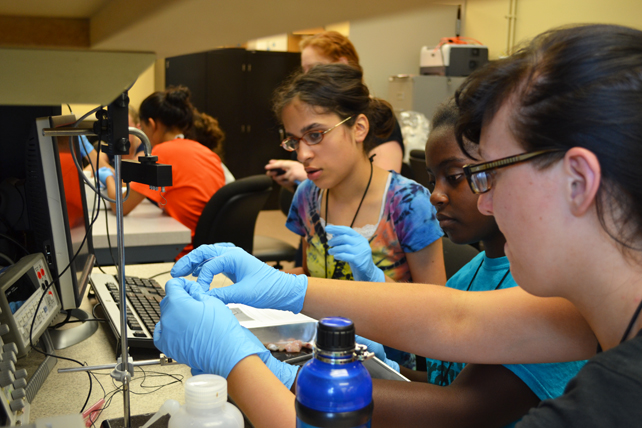
Campers learn about neuromuscular electrical stimulation during a hands-on project involving frog legs.













.jpg)
















